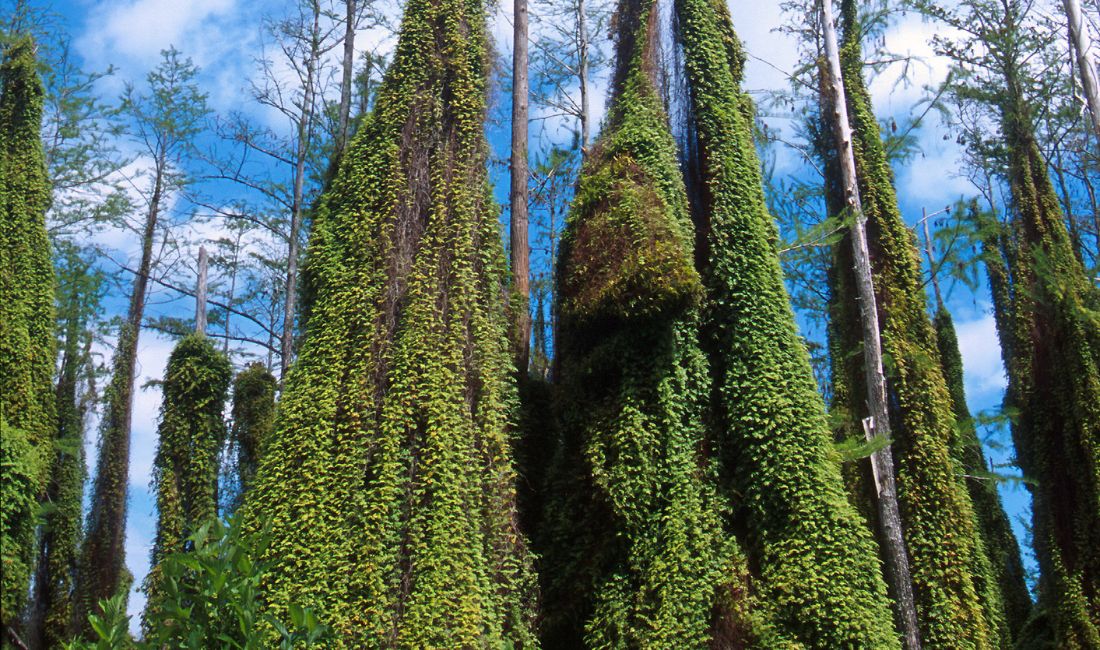While some invasive plants have been in Florida for many decades, one that has been an issue for only around 30 years is the Old World climbing fern (Lygodium microphyllum). Ironically, this somewhat-new invasive may be worse than many of the others in terms of how much it harms our native landscapes.
In this article, we will show you how to recognize the invasive vine known as the Old World climbing fern (OWCF), how it spreads, why it is considered invasive, and what to do if you spot it on your Palm Beach property.

The leaflets of the old world climbing fern. On the left are infertile leaflets; on the right are fertile leaflets with a fringe covering the reproductive tissue.
How to Recognize Old World Climbing Fern
Old World climbing fern, sometimes referred to as climbing maidenhair fern, small leaf climbing fern, or even snake fern is native to Africa, Southeast Asia, and Australia.
When looking for Old World climbing fern on your Palm Beach property, check for a vining plant consisting of fronds with leaflets. The stems are dark brown to black, and the entire vine can grow along the ground, over other plants, and can wind around trees, structures, and even other vines.
OWCF is related to Japanese climbing fern (Lygodium japonicum), another invasive vine, so if either are spotted on your property they should be removed.
The leaflets or pinnae on Old World climbing fern can be fertile or infertile, and often both are found near each other. Fertile leaflets have a fringe on the end that cover the reproductive tissues, while infertile leaflets don’t have this fringe.
Why are Old World Climbing Ferns Problematic?
Invasive Old World climbing ferns are destructive in Florida and should be removed as soon as possible from your Palm Beach property. They are problematic for a variety of reasons, including how quickly and easily they spread, how they cover and steal resources from native vegetation, and how they help fires to spread.
OWCF Spreads Rapidly and Continuously
Old World climbing ferns reproduce and spread through spores, which are carried by wind, water, animals, clothes, vehicles, and any other means of transportation they can take advantage of.
The spores are produced on the fronds, and as new fronds are grown throughout the year, new spores are also produced. Just one leaflet can produce over 28,000 spores. The spores remain viable for up to four years after they are released, which means that even if the vine itself is removed, it can still spread and thus “reappear” during the following few years.
OWCF Covers Native Vegetation
Old World climbing fern will cover native plants, ferns, groundcover, flowers, and even trees, restricting the native plants’ access to sunlight and therefore eliminating any chance of the plants being able to produce energy through photosynthesis. It can completely engulf entire areas, taking all of the resources needed by established plants and trees.
Due to this method of covering and killing native vegetation, it is now considered a Federal noxious weed by the USDA, a noxious weed in Florida (and Alabama), the Florida Invasive Species Council lists it as a Category 1 invasive, and it is one of Palm Beach County’s prohibited plants.
OWCF Helps Fire Spread
Since the Old World climbing fern can cover trees, it creates a pathway for fire to climb from the ground to the top of Florida’s trees. This allows the fire to reach trees that might otherwise be protected from fires, such as those surrounded by water.
Because of this, many endangered plant species are in more danger than ever from being destroyed by fire.

Are there any positives to Old World Climbing Ferns?
In native areas such as Australia, Old World climbing ferns do not take over other native plants but rather grow in harmony in their environment.
At one point, fibers from this vine were used to weave Salakot hats in the Philippines.
Here in Florida, however, there are no known positives to OWCF.
What to Do if You Find Old World Climbing Fern on your Palm Beach Property
If you spot Old World climbing fern on your property, have it removed immediately. It can be cut away or treated with a professional spray.
Keep in mind that once the fern is removed, it can easily return, especially during the period in which the fern spores are still viable (around four years).
Watch closely for any signs of returning OWCF after it has been removed.
Contact Coastal Gardens for Assistance
At Coastal Gardens, we are always on the lookout for noxious weeds, invasive plants, or any other plant or landscape issues on your Palm Beach property. You can trust us to remove and/or control any invasive species.
CALL US TODAY At 561-308-7604
Estate landscape Services
For Fine Properties in Palm Beach
With Coastal Gardens, you can rest easy knowing that your property is taken care of by a dedicated team of estate landscape professionals who truly care about creating and maintaining a dazzling outdoor space you can be proud of.
